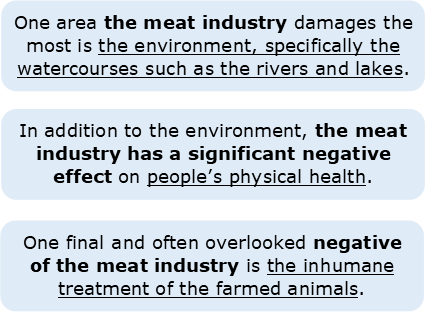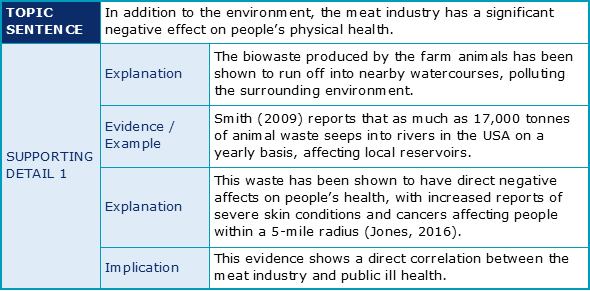How can I write effective academic topic sentences?

This is the second of three chapters about Topic Sentences. To complete this reader, read each chapter carefully and then unlock and complete our materials to check your understanding.
– Review the usefulness of topic sentences in academic essays
– Introduce twelve tips for writing effective topic sentences
– Offer useful examples and activities to help guide the reader
Before you begin reading...
-
video and audio texts
-
knowledge checks and quizzes
-
skills practices, tasks and assignments
Chapter 2
Having introduced the basic concepts of topic sentences in Chapter 1 of this academic reader, we now turn our attention in Chapter 2 to the pieces of advice which make for crafting academic topic sentences effectively and consistently. We’ve identified twelve tips for you below and have provided numerous examples that we hope will be useful when writing your essays, particularly when drafting persuasive body paragraphs.

Tip 1: Identify a Clear Thesis
Because a topic sentence should have a clear connection with the thesis statement of your introductory paragraph, the first thing a writer should do when writing academic essays is identify their central thesis – the main focus of the overall investigation:

Tip 2: Create a Solid Argument Structure
Once you’ve created a thesis (or have been provided with one by your tutor), you may next wish to include an outline in your thesis statement of the main ideas you intend to explore in your body paragraphs. As the following example outline shows, we can expect that the main ideas of this essay will be about the environment, the health of people and the health of farm animals, in that order:

By drafting your argument structure in this way, you’ll be selecting the precise main ideas of each of your body paragraphs. You’ll be considering whether those main ideas are arguments or counter arguments, and you’ll be deciding their order of exploration. Once you’ve collected enough information during the research stage to support these ideas, you’ll then be ready to form effective body-paragraphs.
Tip 3: Include a Topic and a Main Idea
Once you’ve decided on your argument structure, have conducted your research and are ready to write, you’ll want to begin forming your topic sentences. Each body paragraph will require one such topic sentence at the beginning which reminds the reader of the topic of the essay (as stated in your thesis statement) and which introduces more specifically the key main ideas listed in your outline:

As you can see in these examples, each of the three topic sentences (correlating with each of the three body-paragraphs for this imaginary essay) reminds the reader of the topic of the essay – the negative effects of the meat industry – and specifically introduces the various main ideas.

Tip 4: Limit Your Main Ideas
While it’s very important to include one (maybe two) main idea(s), any more than that and your body paragraph runs the risk of offering a shallow rather than deep investigation of the topic. To receive the highest grades at university, you’ll want to make sure that you investigate each of your main ideas thoroughly and that each directly relates to your essay thesis. And if you do decide to include two main ideas in one paragraph, make sure that these two ideas are related closely in theme, such as in the example below about health:

Introduce two dissimilar main ideas in the same paragraph and your reader will probably become confused by your paragraph’s muddled focus, weakening your argumentation and making your essay less convincing.
Tip 5: Link Supporting Details
While the topic sentence might be the most important sentence in a body paragraph, the supporting details are critical also as these are where your main ideas are explored. Without them, your argument would be severely lacking. To make an effective topic sentence therefore requires the inclusion of effective supporting details. The success of these two elements is strongly connected. Any supporting details you provide should be linked clearly and directly to the topic sentence main idea of that same paragraph, as in the examples below:

Should your reader at any point find themselves questioning the relevance of your supporting details in relation to that paragraph’s topic sentence, then the link between these two key body-paragraph elements has not been made clear.
Tip 6: Be Convincing and Engaging
A successful topic sentence should attempt to convince the reader of a viewpoint (or stance) on a particular topic, and should be engaging enough that your reader continues on with interest. However, a good writer should not provide a claim that they cannot provide reasonable evidence for, no matter how engaging or convincing that claim may at first seem. Students should therefore create realistic but intriguing topic sentences, hooking the reader with a unique perspective rather than hyperbole.
Tip 7: Don’t Be Too Vague or Specific
While it may sound somewhat impossible, when constructing topic sentences you should avoid being too vague or too specific. You will want to be specific enough that you provide the reader with a sense of what to expect from your body paragraph without revealing too many key details. You will want to encourage your reader to read on with focus and interest. If you are too vague, you will not be able to sufficiently explore your point within a single paragraph; likewise, if you are too specific in your topic sentence you will have little left to discuss:


Tip 8: Be Concise
Concision is an important aspect of academic writing, and being concise means limiting the length of your topic sentences. Similar to not being too vague or too specific, a good writer should not use any more words than they need to express the topic and the main idea. Remember that a topic sentence should be more specific than your introductory thesis statement but not so specific that the reader has no motivation to read the rest of the paragraph.
Tip 9: Be Flexible
Good topic sentences are a work in progress, and a good writer should be willing to revise them as they go along. Seeing as the topic sentence of a body paragraph should have a strong link to its supporting details, whenever those supporting details need to be revised during the drafting process, the related topic sentence will likely require revision too. Never be afraid to edit and improve, just remember to save older versions of your writing should you wish to later undo those changes.

Tip 10: Proofread Carefully
Another important part of the editing process is proofreading – making sure that you’ve checked your topic sentence carefully for spelling and grammar mistakes. It would be frustrating to spend all that time carefully coverings steps 1 to 9 only to find out after submission that you were missing a punctuation mark or had made a subject-verb agreement error.
Tip 11: Transition Between Ideas
One of the functions of a topic sentence is to allow for a smooth transition from one paragraph to another and to show relationships between ideas, such as compare and contrast or cause and effect. A writer may wish to include the previous paragraph’s main idea using the words ‘in addition’ for example, or demonstrate an opposing argument and concession using ‘although’ or ‘while’:


Tip 12: Look at Example Sentences
One final tip for writing effective topic sentences is to study lots of examples. By reading multiple example topic sentences, by studying the language structures they commonly use, and by noticing how they link back to the introductory thesis statement and forwards to the supporting details, a student should learn to better utilise these patterns in their own writing. Thankfully, our final chapter in this reader has lots of examples for you to check out – so do continue reading.
To reference this reader:
Academic Marker (2022) Topic Sentences. Available at: https://academicmarker.com/essay-writing/body-paragraphs/topic-sentences/ (Accessed: Date Month Year).
Downloadbles
Once you’ve completed all three chapters in this academic reader about Topic Sentences, you might then wish to download our Chapter Worksheets to check your progress or print for your students. These professional PDF worksheets can be easily accessed for only a few Academic Marks.
Chapter 1 explores the topic: Why should body paragraphs have topic sentences? Our Chapter 1 Worksheet (containing guidance, activities and answer keys) can be accessed here at the click of a button.
Chapter 2 explores the topic: How can I write effective academic topic sentences? Our Chapter 2 Worksheet (containing guidance, activities and answer keys) can be accessed here at the click of a button.
Chapter 3 explores the topic: What are examples of the 7 types of topic sentence? Our Chapter 3 Worksheet (containing guidance, activities and answer keys) can be accessed here at the click of a button.
To save yourself 2 Marks, click on the button below to gain unlimited access to all of our Topic Sentences Chapter Worksheets. This All-in-1 Pack includes every chapter, activity and answer key related to this reader in one handy and professional PDF.
Collect Academic Marks
-
100 Marks for joining
-
25 Marks for daily e-learning
-
100-200 for feedback/testimonials
-
100-500 for referring your colleages/friends